Three Perfect Days
Christchurch
Hemispheres, July 2024
Photography by Adrienne Pitts
When you’re in Christchurch, all of New Zealand’s South Island feels spread out before you. The country’s most promising new wine region, Waipara, lies less than an hour’s drive to the north; its majestic Southern Alps are only a scenic train ride to the west; and Kaikōura, home to one of the world’s richest deep-sea habitats, is just a two-hour jaunt up the coast. Even as these wonders beckon, visitors should be sure to take some time to get to know the South Island’s largest city. Thirteen years after an earthquake caused more than $25 billion in damage, Christchurch is in the midst of a renaissance. The rebuild has afforded the city the chance to rewrite its story and, in particular, honor its Māori heritage. Now, Ōtautahi, as it’s known in te reo Māori, is looking forward, embracing its role as a center for arts, cuisine, and innovation. There’s never been a better time to say kia ora.
Day 1
Māori art, a food tour, and a scenic ride in Christchurch
It’s morning in Christchurch, and, thanks to a truly surreal time change, I open the curtains of my room at Sudima Christchurch City to gaze out onto a bright future—literally. Back home in New York, my son is just finishing school yesterday. I realize my brain can’t handle this until I’ve had at least one flat white, so I take a 10 minute-stroll to Miró, an elegant cafe on the Avon River that’s located in one of the last remaining Art Deco buildings that survived the 2011 earthquake. Along with my coffee, I tuck into truffled scrambled eggs on a thick slice of sourdough, topped with herbs and local black truffles. I’m not used to such good food at 8 a.m.
To get my bearings, I walk a block over to Victoria Square and hop aboard one of the city’s historic trams. (Electric ones ran from 1905 until 1954; this heritage tram experience opened in 1995.) We roll past the colorful store- fronts of New Regent Street to Cathedral Square, where we see the plaza’s Gothic namesake still shrouded in scaffolding. The whole area bristles with cranes and construction. “This sums up Christchurch after the earth- quake,” says our conductor, Gordon Tramway (“Yes, as in tram,” he jokes). “Lots and lots of new buildings and lots and lots of demolition.”
A few stops later, I hop off at the Christchurch Art Gallery Te Puna o Waiwhetū. (The Māori name honors the artesian spring on top of which the gallery was built.) The soothing mantra, “Everything is going to be alright” glows from one side of the building’s facade, rendered in neon by the British artist Martin Creed. Inside, I take in modern works by Māori artists, including Robyn Kahukiwa’s Tena I Rula, a striking painting of women from her iwi, or tribe, per- forming a haka, a ceremonial dance of empowerment.
I want to linger, but I’m due to meet Ash Jefferys of Āmiki Tours at The Obser- vatory Hotel, located at The Arts Centre Te Matatiki Toi Ora, for a cultural food tour. Jefferys welcomes me with a beaming grin and a traditional Māori greeting— identifying herself not by her name, but by where she’s from. “Every new person is a new friend,” she tells me. “And every new friend is an excuse to eat.”
Our first stop is The Fudge Cottage, where I try pieces flavored with feijoa, a small, green-skinned tree fruit sometimes called pineap- ple guava. (To me, the taste is more flowery than fruity.) I spot a bar labeled Hokey Pokey that the shopkeeper says is made with honey- comb. “Why’s it named Hokey Pokey?” I ask. “It’s just named for the dance,” she replies, proceeding to do the hokey pokey and turn herself around. “I don’t know why!” I buy two.
From here, we walk along the river, and Jefferys points out paved artworks that represent whāriki— traditional Māori woven mats whose designs each tell a story. Jefferys is of Māori and Samoan descent but only started learning te reo Māori a few years ago, since it was discouraged when she was growing up. Now, she’s learning the language from her sister’s family. She prac- tices with the children: “It’s quite funny having language lessons with a 3-year-old,” she says with a laugh.
Our next stop is King of Snake, a Euro-Asian restau- rant in the Central Business District that Jefferys says encompasses the Māori ideal of manaakitanga. “It’s really welcoming and inclusive,” she says, “because it caters to all dietary restrictions.” She orders us a handful of dishes to try; the standout is a moong dal salad with avocado, pumpkin seeds, and a lime dressing.
We wander on through Riverside Market, a food hall where 32 stalls sell every- thing from manuka honey to ramen to souvlaki. As we walk, I ask Jefferys about the large, green-stone necklace she wears. “It’s pounamu,” she tells me. “It’s a sacred stone primarily found on the west coast of the South Island. You can’t buy it for yourself; you have to receive it, and you have to think about the intent of giving it.” At the design shop Hapa, I ogle the beautiful pounamu jewelry for sale, sad that I can’t treat myself.
I console myself with goat cheese croquettes, bone mar- row, and whipped ricotta with candied tomatoes at Bar Franco, a Mediterranean spot down the street that opened last September. I’m fit to burst—and grateful Jef- ferys doesn’t order dessert.
After all that eating, I need a long walk, so I hug Jefferys goodbye and head to the 161-year-old Christchurch Botanic Gardens. Dahl- ias, my favorite flower, are blooming, and more than once I have to run from the giant bumblebees that are equally smitten with the perennial (and, it seems, my hair gel). I may be in the mid- dle of the city, but I’m able to escape into “the bush” of the New Zealand Gardens, a veritable Jurassic Park set piece of lush silver ferns, towering kahikatea (white pines), and tropical-looking cabbage trees.
Dinner tonight is in Lyt- telton, a port town that’s basically the Brooklyn to Christchurch’s Manhattan. I hop a rideshare in that direction, making a stop along the way at the Christ- church Gondola. On the climb, I gape at the views of the city, the Southern Alps, and Lyttelton Harbor.
Back on the ground, I pro- ceed to Mapu Test Kitchen, a six-seat spot manned by culinary wizard Giulio Sturla. There’s no set menu—the only item that always appears is pan de yuca, a chewy cheese bread from Ecuador, where Sturla grew up. Instead, he’s driven by seasonality, by the availability of ingredients, and by how he’s feeling that day. “For me it’s not about cooking,” he says. “It’s cre- ating flavor with time.”
Today, the flavors on offer include kingfish with yuzu, finger limes, and 3-year- old miso made with corn rather than soy—something inspired by a recent trip to China. “I think, How can I create this product with something from New Zea- land?” Sturla says. “It’s not about bringing things from other countries; it’s about creating it myself, here.” The most exciting dish is a mystery—truly. Sturla asks the diners to guess which fruit he used to make the noo- dles in a dish of langoustine scampi. Apples? Peaches? Cantaloupe? He smiles big- ger with every wrong answer. “Bananas,” he finally divulges. It’s a gluten-free revelation.
For Sturla, a meal is much more than food on a plate: “With Taylor Swift, you pay $500 to listen and look at her. Two senses are involved. But when you are in a restaurant you hear stories, you see and taste and smell the food. There are so many senses.”
This will be controversial, no doubt, but I’d rather pay $355 NZD (about $217) to eat here than to see Taylor.
The final dessert seals the deal: purple peach gnocchi with rhubarb ice and yel- low kiwi fruit curd. I take a bite and let out an audible “mmmm.” Sturla smiles. “I know, right?” he says with a wink.
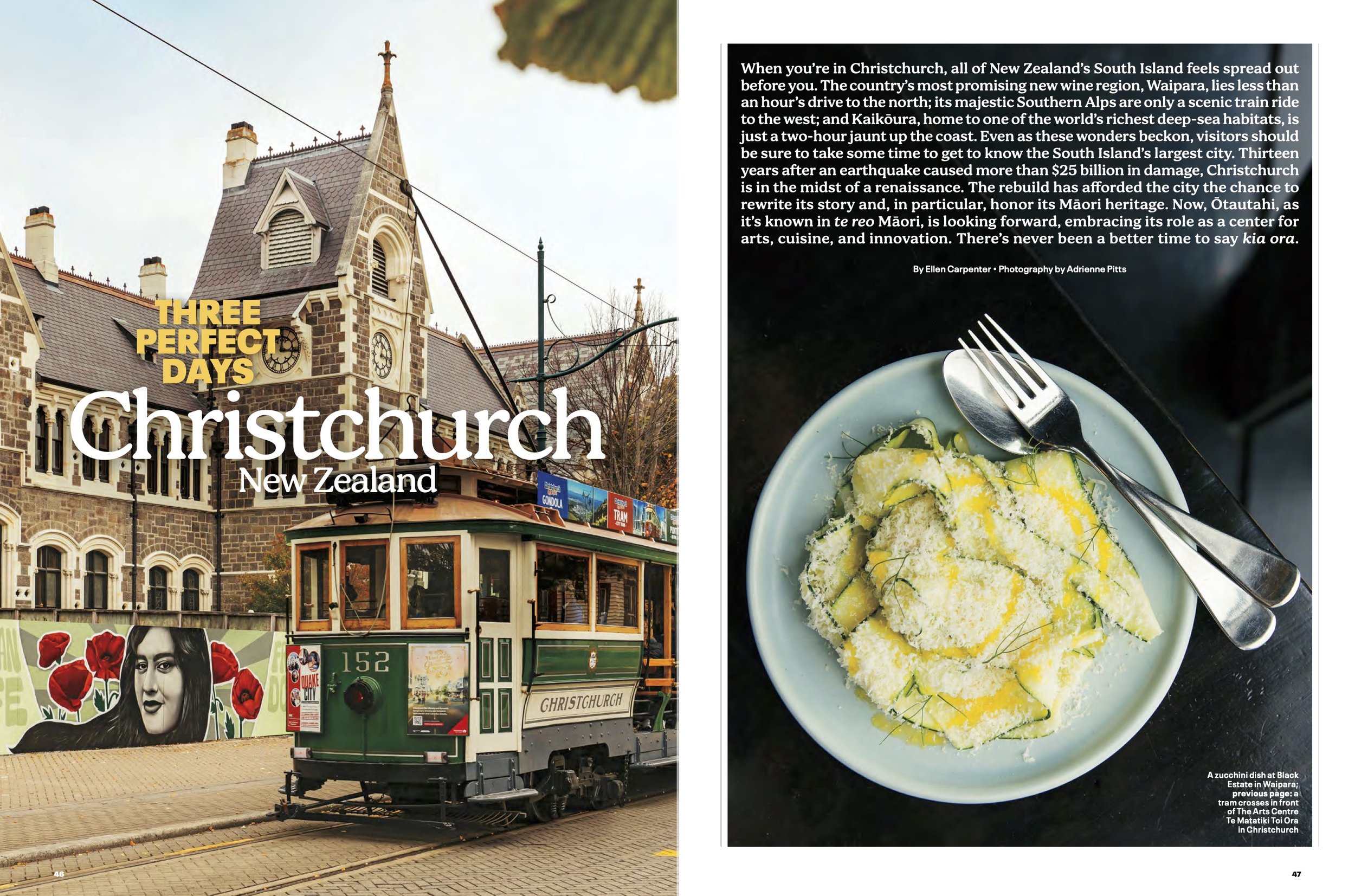
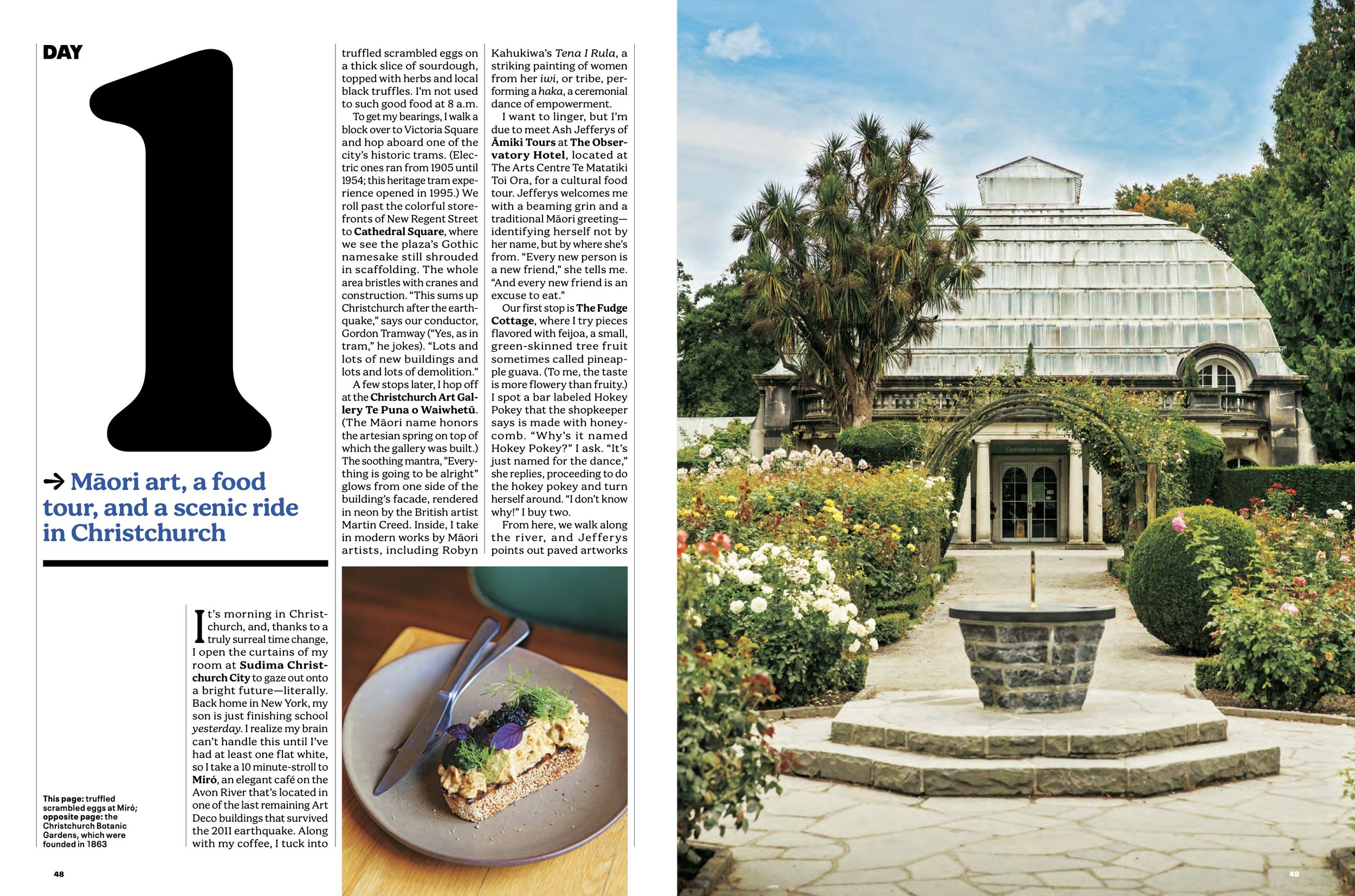
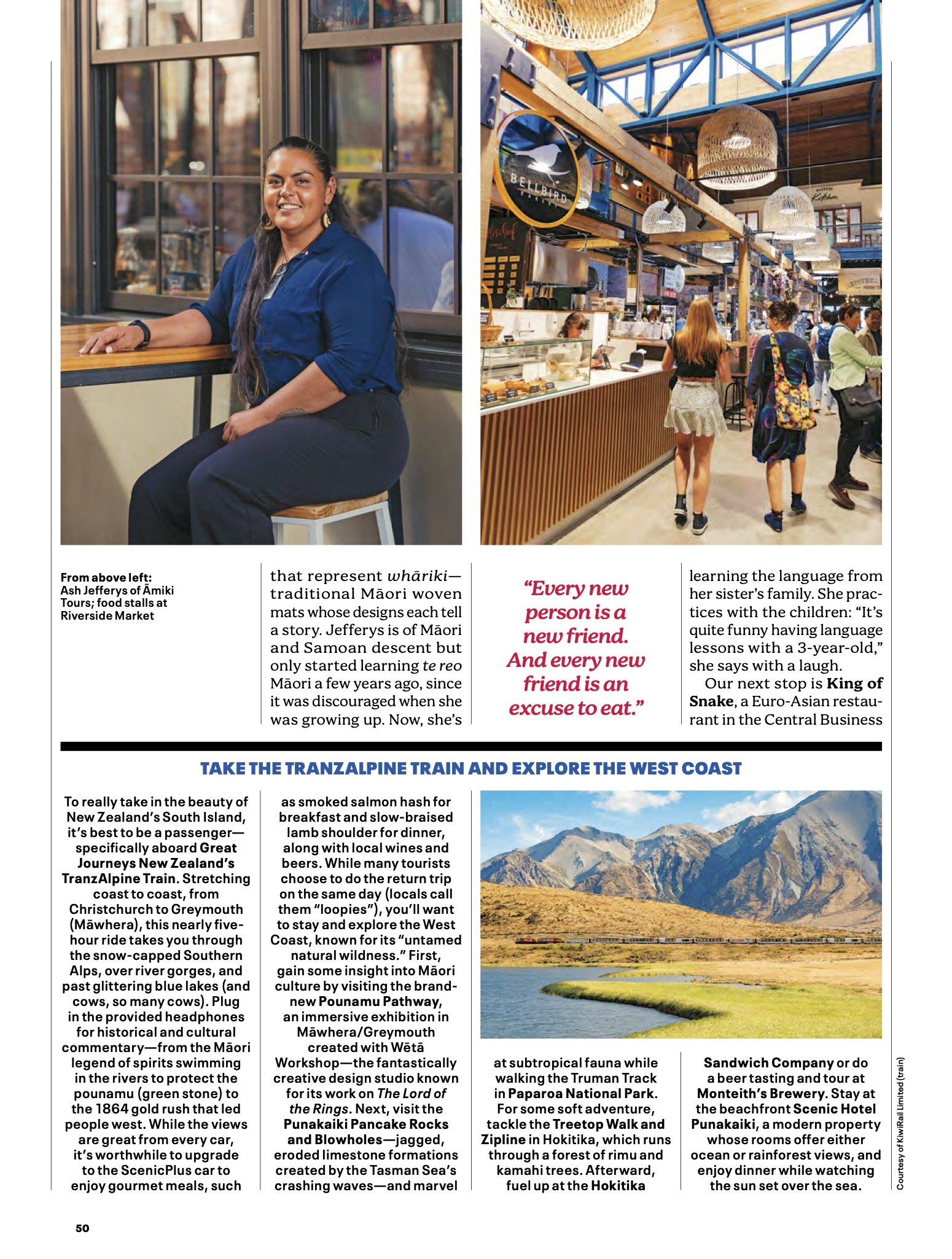
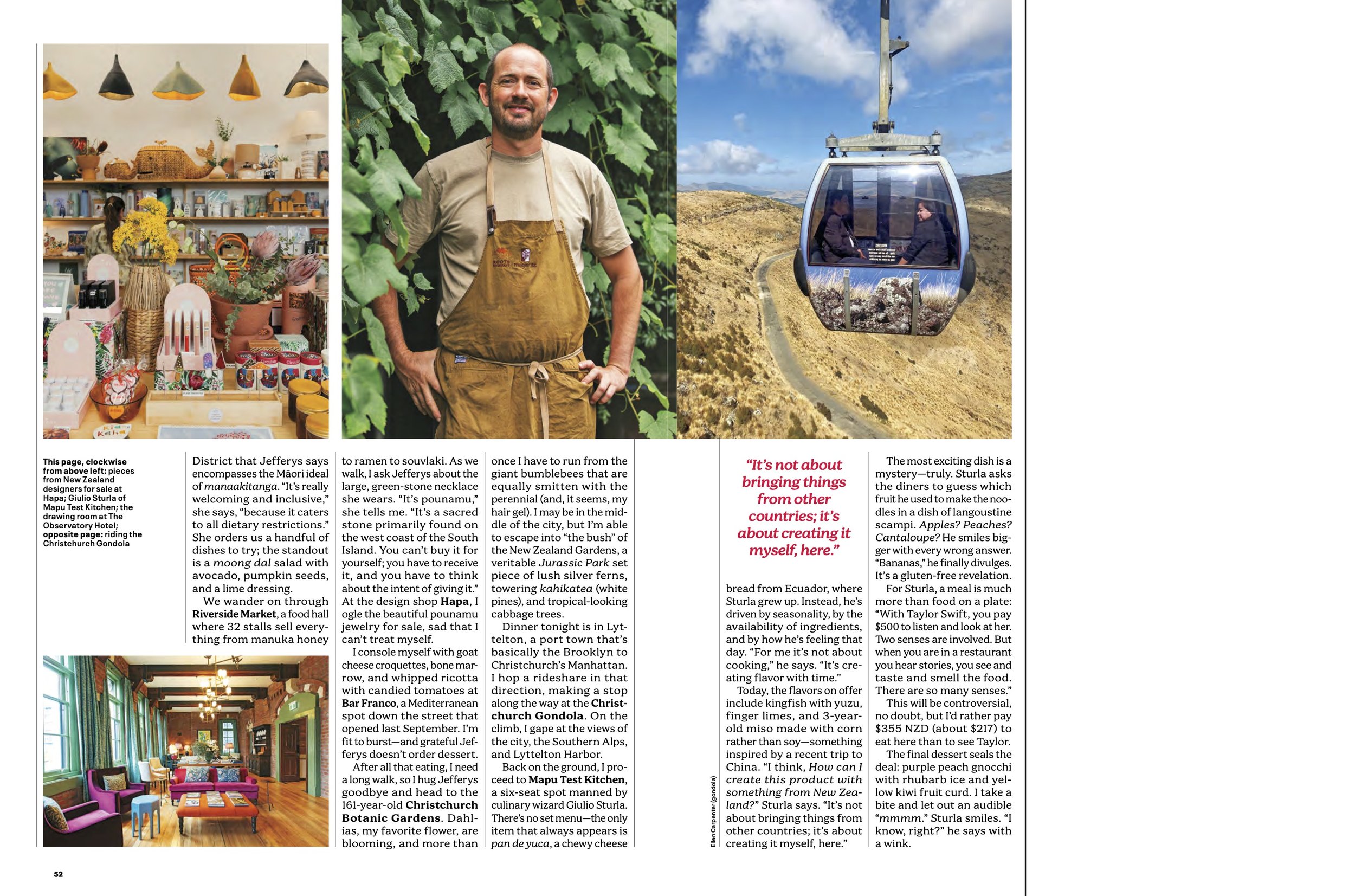
DAY 2
Punting on the Avon River and wine-tasting in Waipara
After last night’s brilliant feast, I start today a bit closer to the ground. My Instagram knew I was coming to Christchurch and targeted me—a dog owner—with a post on a local café where you can get an image of your dog printed on top of a cocoa. So, I start my morning off at C1 Espresso, laughing hysterically as I drink a hot chocolate with a perfect image of my terrier mix, Finn, staring back at me, like Our Lady of Guadalupe on the face of a tortilla. I supplement this with a flat white and a bowl of granola, chia pudding, and poached pear.
I’m heading out to the Waipara wine region and Kaikōura today, but after jealously watching people punt down the placid Avon River yesterday, I decide I need to have that experience before I hit the road. At the 142-year-old Antigua Boat Sheds, I line up alongside a group of cheery tourists and then step onto a long, flat-bottomed boat. “If you put your hand in the water, the eels may try to bite you,” warns our punter, Mike. My mind flashes to the shrieking eels in The Princess Bride, and I shove my hands into my pockets.
We weave down the river, under weeping willows and past graceful paradise shelducks, which Mike tells us are named pūtangitangi in te reo Māori. “It means ‘crying baby,’” he explains, “because the ducks go waaah, waaah!” Thankfully, the actual baby sitting on his mom’s lap in front of me just smiles. We make our way into the Botanic Gardens, and Mike tells us about the city’s first oak tree, planted in the 1860s, after Queen Victoria mailed acorns. “It’s a royal, protected tree,” he says. “You’ll be fined if you climb it.” When it’s time for Mike to turn the boat around and head back, he jokes that “punting is the most extreme sport in New Zealand” and encourages us to put our hands in the air and scream like we’re on a roller coaster. A man sitting on a bench by the river looks up from his paper and shakes his head.
Back on dry land, I head to the Sudima to gather my bags and my rental car. I hit play on Woodface, the 1991 album from New Zealand’s beloved Crowded House, and hit the road. Soon enough, the city gives way to story- book rolling hills dotted with sheep. (Fun fact: New Zealand’s sheep to people ratio is 5 to 1!) Less than an hour later, I pull into Black Estate, a family-run vineyard that’s as renowned for its multicourse lunches as its award-winning pinot noirs. I score a table overlooking the vineyard and dig into chicken-liver parfait with spiced apples and lavash, barbecued lamb with preserved lemons, mead- glazed carrots with whipped
ricotta, and a glass of 2017 pinot noir, made using grapes from the vine- yard right in front of me. Co-owner Pen Naish stops by to check on me and ends up telling me the story of how she and her husband, Nicholas Brown, purchased the vineyard in 2007 and turned it into a dining destination. “We were just going to do a tasting room,” she says, “but we realized food needed to be a part of the story.”
I add a chapter to my own tale down the road at Pegasus Bay Winery, one of the granddaddies of Waipara, having been established in 1985. I feel as if I’ve stumbled into the ultimate garden party: Families at long picnic tables laugh and toast, young women in summer dresses celebrate a hen weekend, kids run across the lawn blowing bubbles. Red, pink, and orange dahlias frame the scene.
I find marketing manager Ed Donaldson among the rev- elers, and he tells me how his parents fell in love with wine after receiving expert Hugh Johnson’s simply titled book, Wine. They traveled through Europe, gleaning everything they could, and came back to New Zealand to start one of the first vineyards in Canter- bury. Today, it’s a full family affair, with Donaldson and his three brothers all playing vital roles. While the Marl- borough region north of here is now world-famous, North Canterbury and Waipara are still relatively unknown— and Donaldson is fine with that. “We don’t equate get- ting bigger and bigger to being happier,” he says. “We wouldn’t survive making lots of low-cost wine. We’re pretty much everywhere we want to be now.”
He leads me inside to the barrel room for a tasting. My New Zealand wine knowledge is limited to bright Marlbor- ough sauvignon blancs, and I’m wowed by the complicated personality and verve in each Pegasus offering I sip (and spit—I am driving, after all). The riesling and pinot noir are standouts, but I choose a bot- tle of 2020 chardonnay—with a fascinating struck-match finish—to bring home.
I have about an hour and a half before I reach Kaikōura, and soon enough I’ve traded tan, Montana-like mountains for a rugged coastline. The road curves along the ocean, waves crashing against black rocks, and I spot dol- phins leaping in the air, as if jumping for joy that I’ve finally made it.
It’s golden hour when I arrive at Hapuku Lodge + Tree Houses. I’m greeted by the property’s herd of deer, which I can see from the picture window in my contemporary tree house. It looks straight from the pages of Dwell.
I freshen up for dinner and head down to the main building, where I meet gen- eral manager Emile Van der Linde. A South Africa native and avid surfer, Van der Linde first came here as a guest 16 years ago. “I got upgraded to a tree house, and by the time I checked out I went to the manager’s desk and said, ‘Hi, I work here now.’ It took about six or eight months before he hired me.” Taking in the beauty of the land, with the Kaikōura Ranges to the west and Hapuku Beach to the east—not to mention the cool factor of the tree houses nestled into a lush kanuka grove—I can totally understand his reasoning.
The spectacular dinner begins with Marlborough green-lipped mussels in a smoked chili sauce with coriander and lime, then proceeds on to barbecued picanha (beef round) with potato terrine, grilled zuc- chini, and black garlic aioli. I stop myself from cleaning my plate so I can save room for dessert: strawberry sor- bet with rhubarb compote and strawberry meringue. As I take my last bite, I can’t help but wonder if Van der Linde is hiring.
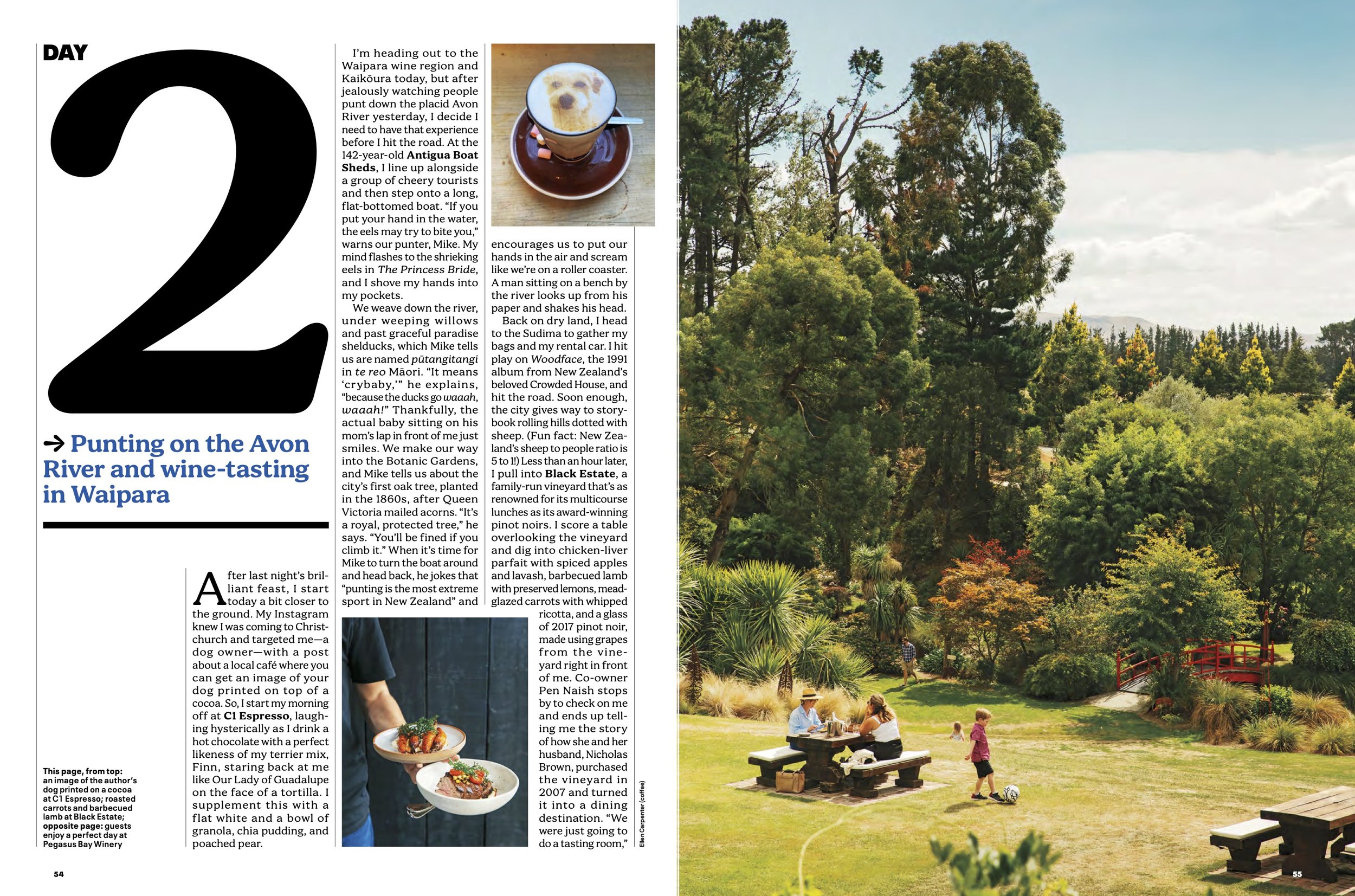
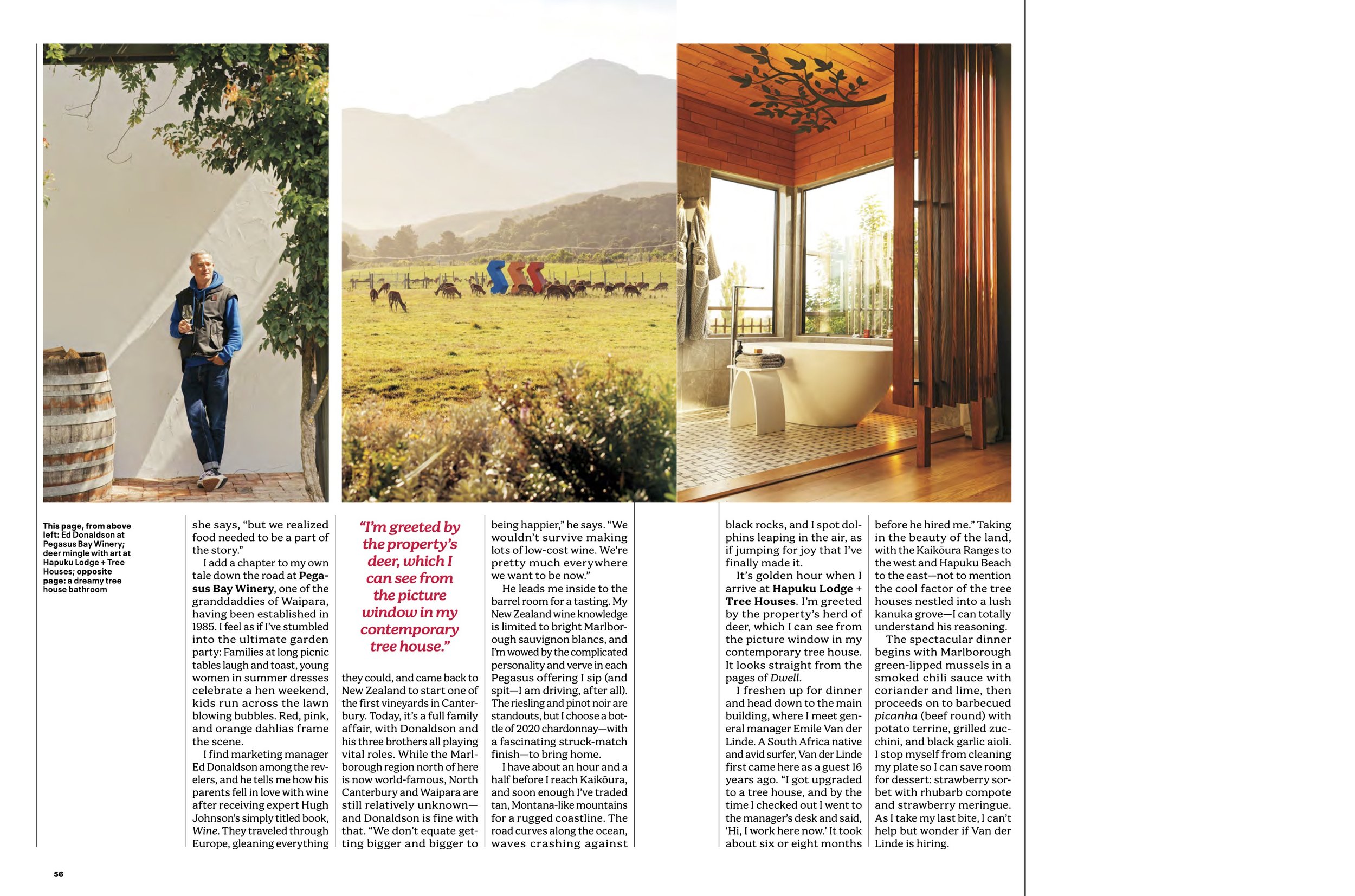
Day 3
Swimming with dusky dolphins and learning to cook in Kaikōura
It’s only 8:30 a.m., and I’m in a changing room at Dolphin Encounter Kaikōura, squeezing into a wet suit for the first time in my life. “I feel like this is what a Kardashian must always feel like,” says the woman next to me. We agree, though, that snug clothes are a small price to pay for the chance to swim with dolphins.
After a safety video, we (along with 30 other lucky adults) pile onto our boat, the Moana Nui. One of our guides, Tracy, explains that this area teems with marine life—up to 100 times more than other similar habitats— because of the Kaikōura Canyon, which is more than a mile deep. Here, the cold waters from Antarctica com- bine with warm currents, creating an abundant food supply that keeps whales, dolphins, and seals satiated year-round.
We’re not on the boat for five minutes before someone spots a pair of orcas. We all rush to the back of the boat to ooh and ahh and take photos of the mom and baby breaching. It’s my first time seeing a whale, and I’m giddy with excitement.
Two minutes later, when the guides spot a pod of dusky dolphins and tell us it’s time for our first swim, I’m terrified. I look around at my fellow passengers eagerly slipping on their masks and jumping into the ocean. Are none of them concerned that we’re about to get into water where we just saw orcas? Regardless, I do what I’m told and slip into the Pacific. I’m immediately bumped by a dolphin swimming by and go into full-on panic mode, gasping and paddling like a dog. I climb back on the boat, and Tracy puts her hand on my shoulder. “I can tell you’re nervous,” she says, like a patient kindergarten teacher. “Breathe slowly, don’t flail about, and keep your arms by your side. And sing to them.”
On our next swim, I do as she says, and it’s incredible. The dolphins encircle me playfully, zipping past and leaping into the air as I trill like Xena the Warrior Prin- cess. After two more swims, I feel like I could do this all day.
It’s lunchtime, though, and I’m signed up for a cooking class at Hapuku Kitchen. Owner Fiona Read welcomes me into her gorgeously decorated 1930s cottage— whimsical wallpaper, quirky light fixtures, eye-catching art—and, after a divine cheese and chive scone, puts me to work. I take a basket to the garden and gather bright yellow squash blossoms, as well as cherry tomatoes and herbs.
A former MasterChef New Zealand competitor, Read moved from Wellington to Kaikōura with her husband, Chris Sturgeon, for a job cooking at Hapuku Lodge. They took over managing the lodge for a while, until 2020, when they decided to open Hapuku Kitchen. “We put ourselves in the shoes of the traveler,” she says. “They want to meet people and learn about the culture.”
In the kitchen, Read’s assistant, Jerusha Hislop, helps me prepare a ricotta filling for the squash blossoms. I pipe the filling into the flowers, twist them shut, and dredge them in a flour batter. They emerge from the bub- bling oil lightly crisped and tanned. We blister the cherry tomatoes, douse them with olive oil and basil, and take our bounty outside to eat. Butterflies flit about. Birds sing. I couldn’t be happier.
Having enjoyed Kaikōura from both the water and the land, I’m about to do so from the sky, on a whale sightseeing flight with South Pacific Helicopters. As our group walks out to the EC130 chopper, founder Dan Stevenson warns us, “You’re never guaranteed a whale sighting, so just enjoy the scenery.” He pauses, then adds, “You do get to spend about 45 minutes with me, so that’s a bonus.”
Fortunately, we spot a sperm whale just a few min- utes into our ride. He puts on a show for us, diving down into the water and flipping his tail like he’s in some NatGeo doc. “This is why Kaikōura is so unique,” Stevenson says through his headset. “We can see a sperm whale just off the shore; other places you have to go much further out.”
“How much did you pay him?” I ask. Stevenson laughs. “A lot!”
We also spot pods of dusky dolphins before turning toward the moun- tains. “I heard you requested the Loops and Barrel Rolls package,” Stevenson jokes as we scooch over a jagged peak that’s much higher than I was expecting. I’m overwhelmed by Kaikōura’s beauty—how in one day I can see incredible marine life and epic mountains.
There’s still one animal I haven’t seen, though, and it’s my favorite. I’ve been told there’s a New Zealand fur seal colony on Ohau Point, just 20 minutes away from where our helicopter touches down. I make the quick drive, park, and walk along the rocky coastal path for a few minutes, squinting to spot the seals. Then, suddenly I’m rewarded with dozens— hundreds?—of them. They’re sunning themselves, swimming, scratching their backs on the rocks. I even spot two pups nursing, and I’m grateful I have a tissue in my pocket, because tears are falling fast down my cheeks.
I have to tear myself away from my spirit animal because I know that Nins Bin closes at 6. I’ve been told I can’t leave without eating crayfish—kaikōura actually means “to eat crayfish” in te reo Māori—and apparently this blue-and-white-striped roadside eatery serves some of the best. I get mine doused in garlic butter and take a seat on a picnic table over- looking the water. Seagulls swoop in, angling for a bite, but I shoo them away. The sun sits low, giving the sky a soft, orange glow. As I eat, I think of how the Māori peo- ple who settled here nearly 800 years ago also sat on the rocky coast, eating crayfish cooked over fire.
The sun has set by the time I make it back to Hapuku Lodge. I take a bath in the deep soaking tub, reliving the events of my magical day. I remember how, on my first day in Christchurch, Ash Jefferys told me about manaakitanga—the Māori way of welcoming guests and making them feel sup- ported and cared for. That’s how I feel: supported, cared for, and so, so grateful for the warmth and openness of everyone I’ve met.
And for the seals. I’ll always be grateful for the seals.
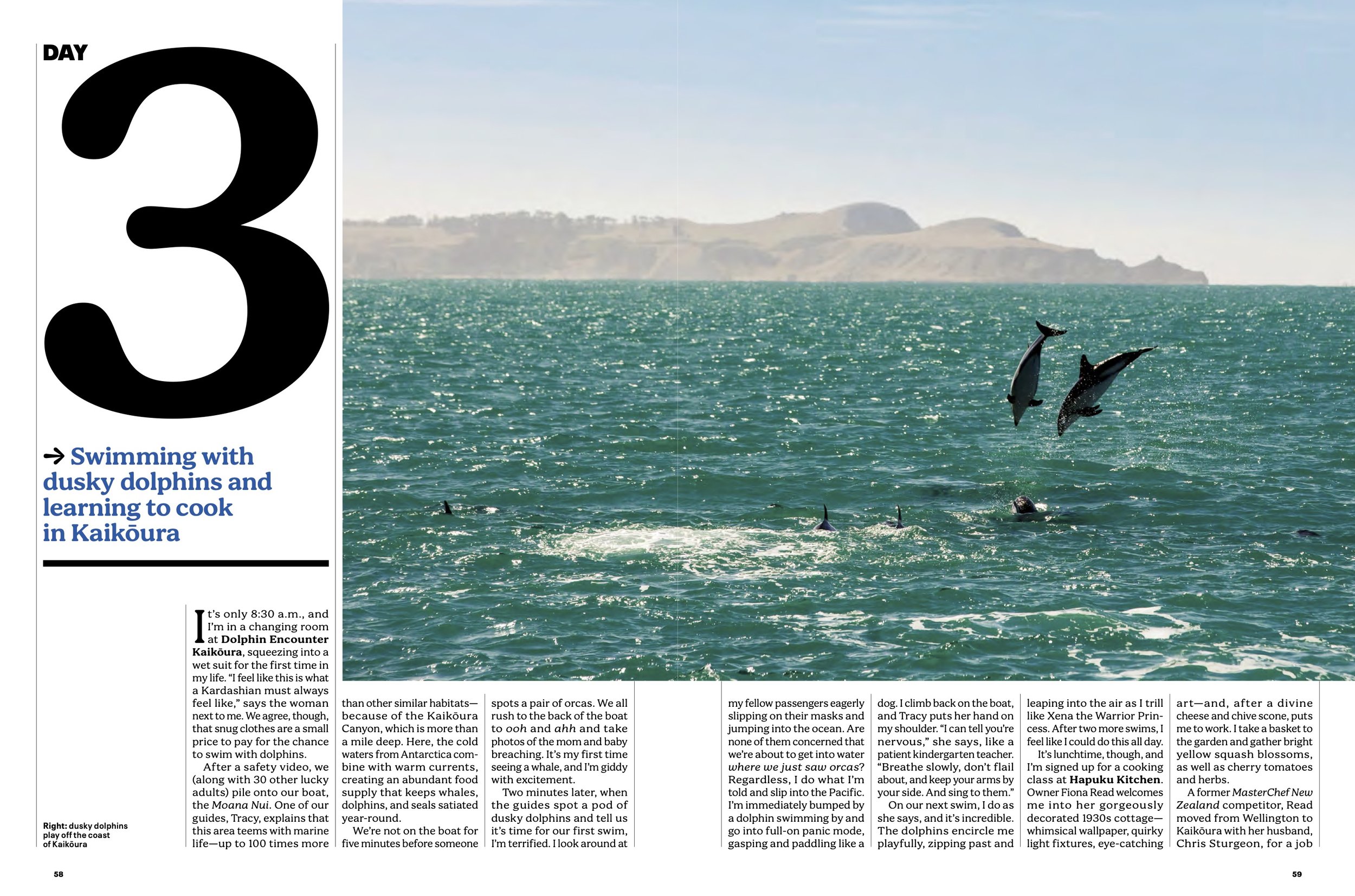
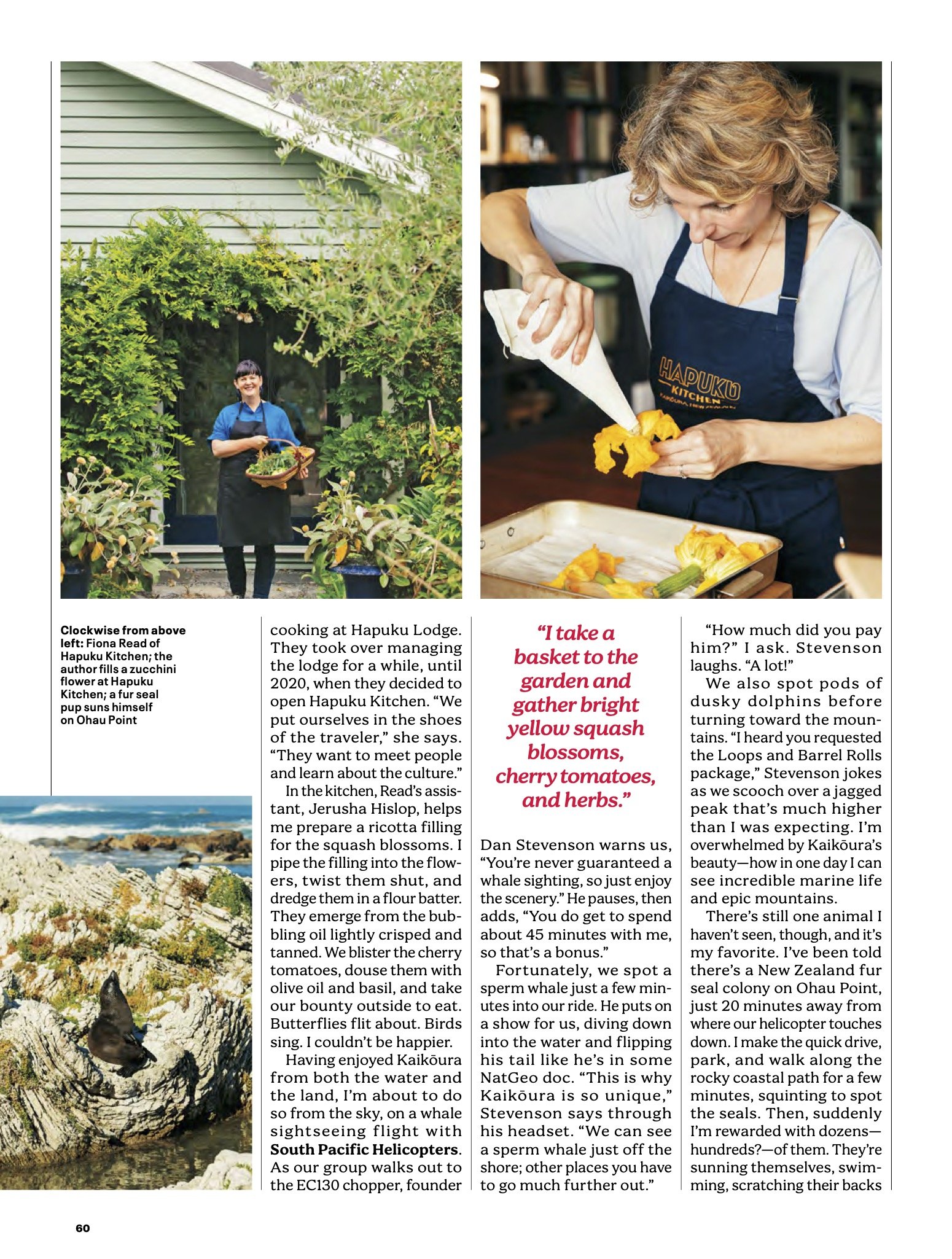
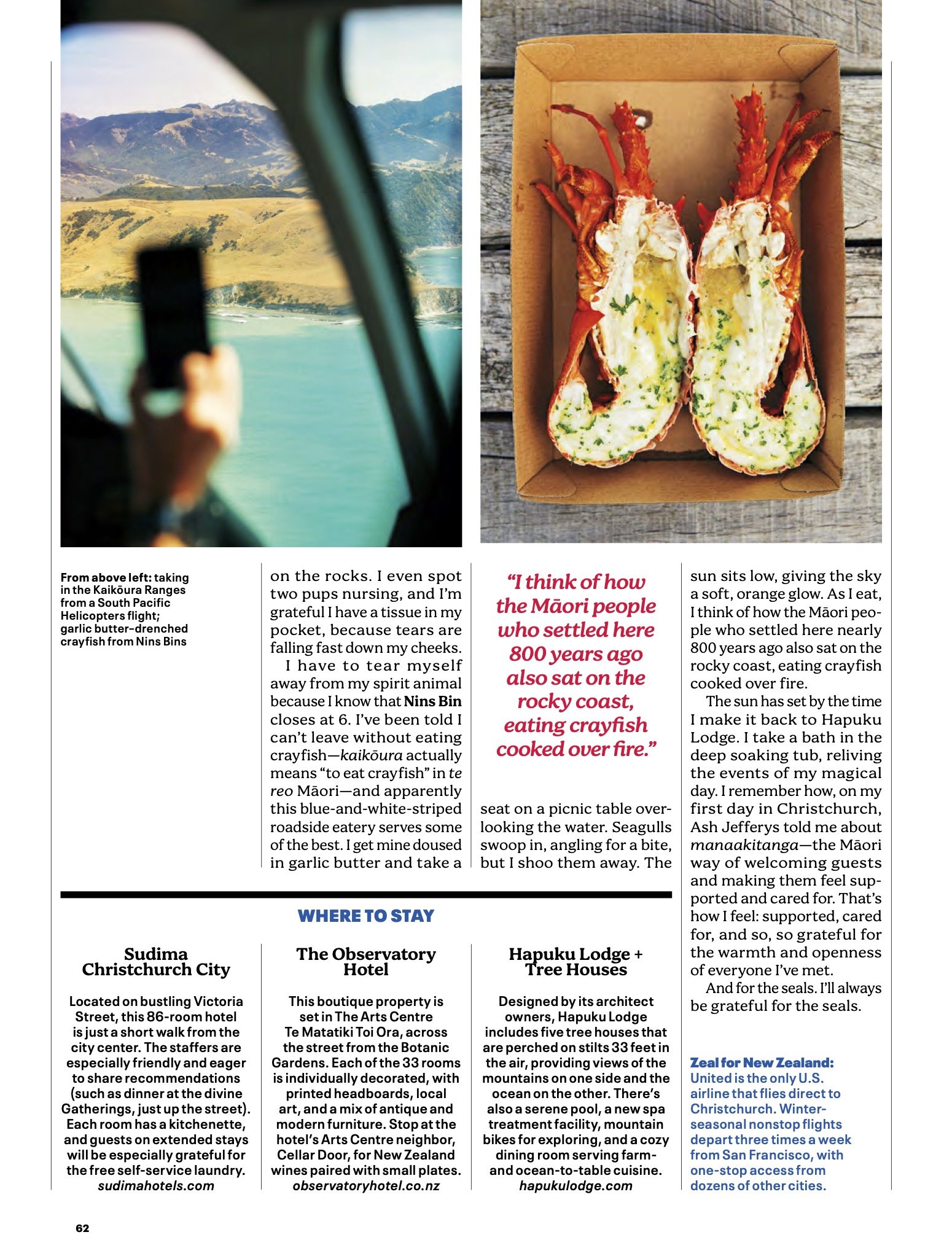
STAY LONGER
Take the TranzApine Train and Explore the West Coast
To really take in the beauty of New Zealand’s South Island, it’s best to be a passenger— specifically aboard Great Journeys New Zealand’s TranzAlpine Train. Stretching coast to coast, from Christchurch to Greymouth (Māwhera), this nearly five- hour ride takes you through the snow-capped Southern Alps, over river gorges, and past glittering blue lakes (and cows, so many cows). Plug
in the provided headphones for historical and cultural commentary—from the Māori legend of spirits swimming in the rivers to protect the pounamu (green stone) to the 1864 gold rush that led people west. While the views are great from every car, it’s worthwhile to upgrade to the ScenicPlus car to enjoy gourmet meals, such as smoked salmon hash for breakfast and slow-braised lamb shoulder for dinner, along with local wines and beers. While many tourists choose to do the return trip on the same day (locals call them “loopies”), you’ll want to stay and explore the West Coast, known for its “untamed natural wildness.” First, gain some insight into Māori culture by visiting the brand- new Pounamu Pathway, an immersive exhibition in Māwhera/Greymouth created with Wētā Workshop—the fantastically creative design studio known for its work on The Lord of the Rings. Next, visit the Punakaiki Pancake Rocks and Blowholes—jagged, eroded limestone formations created by the Tasman Sea’s crashing waves—and marvel at subtropical fauna while walking the Truman Track in Paparoa National Park. For some soft adventure, tackle the Treetop Walk and Zipline in Hokitika, which runs through a forest of rimu and kamahi trees. Afterward,
Sandwich Company or do
a beer tasting and tour at Monteith’s Brewery. Stay at the beachfront Scenic Hotel Punakaiki, a modern property whose rooms offer either ocean or rainforest views, and enjoy dinner while watching the sun set over the sea.
WHERE TO STAY
Sudima Christchurch City
Located on bustling Victoria Street, this 86-room hotel is just a short walk from the city center. The staffers are especially friendly and eager to share recommendations (such as dinner at the divine Gatherings, just up the street). Each room has a kitchenette, and guests on extended stays will be especially grateful for the free self-service laundry. sudimahotels.com
The Observatory Hotel
This boutique property is set in The Arts Centre Te Matatiki Toi Ora, across the street from the Botanic Gardens. Each of the 33 rooms is individually decorated, with printed headboards, local art, and a mix of antique and modern furniture. Stop at the hotel’s Arts Centre neighbor, Cellar Door, for New Zealand wines paired with small plates. observatoryhotel.co.nz
Hapuku Lodge + Tree Houses
Designed by its architect owners, Hapuku Lodge includes five tree houses that are perched on stilts 33 feet in the air, providing views of the mountains on one side and the ocean on the other. There’s also a serene pool, a new spa treatment facility, mountain bikes for exploring, and a cozy dining room serving farm- and ocean-to-table cuisine. hapukulodge.com
